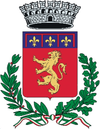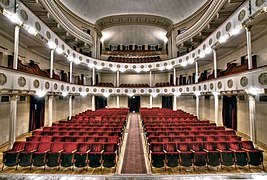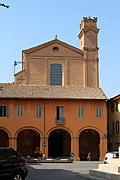Budrio
| Budrio | ||
|---|---|---|

|
|
|
| Country | Italy | |
| region | Emilia-Romagna | |
| Metropolitan city | Bologna (BO) | |
| Local name | Bûdri | |
| Coordinates | 44 ° 32 ' N , 11 ° 32' E | |
| height | 26 m slm | |
| surface | 120 km² | |
| Residents | 18,545 (Dec 31, 2019) | |
| Population density | 155 inhabitants / km² | |
| Post Code | 40054 | |
| prefix | 051 | |
| ISTAT number | 037008 | |
| Popular name | Budriesi | |
| Patron saint | San Lorenzo | |
| Website | www.comune.budrio.bo.it | |
Budrio is an Italian commune ( comune ) with 18,545 inhabitants (as of December 31, 2019) in the metropolitan city of Bologna , Emilia-Romagna region .
geography
The place is located in the Po plain about 16 kilometers northeast of Bologna on the orographic right side of the Idice river at 26 m slm
history
The area around Budrio was a Roman colony in which former legionaries were settled. Because of the remains found in the area, it is assumed that the original town center dates from the 10th century. The church of San Lorenzo existed as early as 1146. In the 14th century it was rebuilt as a castle by Cardinal Gil de Albornoz , of which two large towers (1376) can still be seen.
The city wall, of which two towers have been well preserved, dates from the 17th century. Giuseppe Barilli was born in Budrio in 1812, nicknamed Quirico Filopanti , who was appointed Professor of Water Mechanics at the University of Bologna in 1860 .
On October 21, 1944 there was a firefight in the district of Vigoroso between units of the Resistance and the Wehrmacht . Eight resistance fighters were killed in the fight, which lasted several hours. As reprisals , eight more people, including five women, were murdered by members of the field replacement battalion of the 305th Infantry Division and the fascist Black Brigades .
On the morning of April 20, 1945, units of the 8th British Army liberated the town after several days of fighting with Wehrmacht units during the Allied spring offensive .
Administrative division
The municipal area of Budrio also includes the fractions : Armarolo, Bagnarola, Cento, Dugliolo, Maddalena di Cazzano, Mezzolara, Prunaro, Riccardina, Vedrana and Vigorso.
Public facilities
Budrio has a restored city theater, a city museum with an art gallery, a public bath, two secondary schools and a nursing home for the disabled.
Business
Budrio is world famous for the manufacture of lower leg prostheses . There is a large industrial area on the outskirts. The cultivation of potatoes is particularly important in the area around Budrio.
Attractions
The Bentivoglio Castle (16th century) and the Villa Ranuzzi Cospi in the Bagnarola district are well worth seeing .
Others
Budrio is also known for the new shape of the ocarina , a musical instrument created by Antonio Donati .
Twin cities
-
Eichenau , ( Upper Bavaria ), since 1991

-
Gyula , ( Békés county ), since 1992

sons and daughters of the town
- Aldo Donati (1910–2011), football player
Web links
Individual evidence
- ↑ Statistiche demografiche ISTAT. Monthly population statistics of the Istituto Nazionale di Statistica , as of December 31 of 2019.
- ↑ E. Silvestri: insediamenti Romanized nelle maglie centurialiche Budrio. In: Il territorio di Budrio nell'antichità. Budrio 1983 pp. 26-43
- ↑ Vigoroso Podere Mazzacavallo Budrio October 21, 1944. In: straginazifasciste.it. Retrieved January 31, 2019 (Italian).
- ^ Budrio, (BO) 1919/1945. In: storiaememoriadibologna.it. Retrieved January 31, 2019 (Italian).
- ↑ Federica Rimondi: I disegni e le incisioni della Pinacoteca civica di Budrio. Grafis, Bologna 1997.






